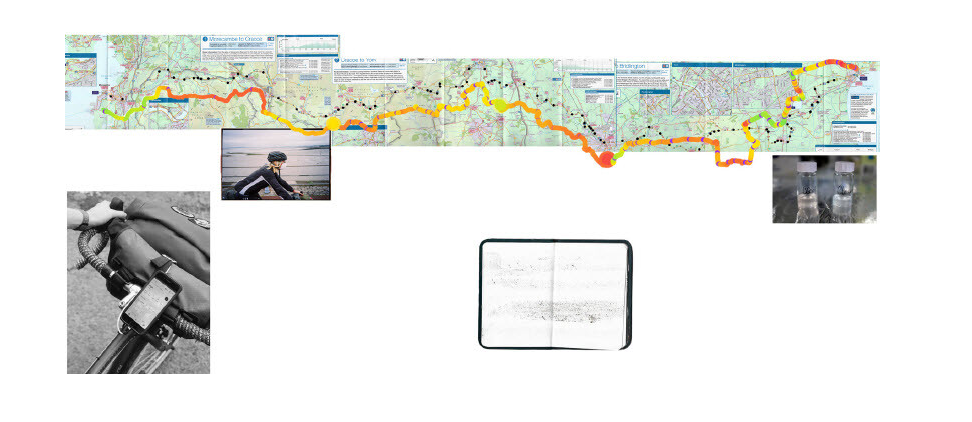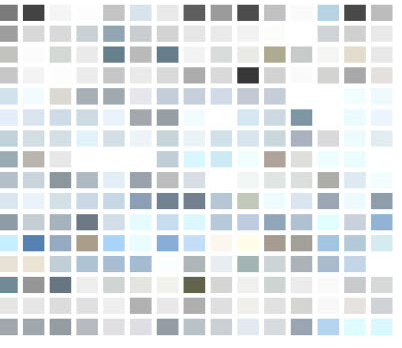Continuing research into research methods, I came across this article about the potential for more performative approaches to collecting data. Performance-as-research sets the tone for a project that may be ‘performed’ and therefore seen as a more creative methodology within fieldwork.
Airpocalypse
Cycling as a performative art methodology for investigating air pollution- Clare Nattress
This article describes an ongoing practice-based research project in which I am using cycling as a performative method to research air quality, working in collaboration with atmospheric scientists at the University of York. From 6 to 8 August 2020 I cycled Coast-to-Coast from Morecambe, Lancashire, to Bridlington, East Riding of Yorkshire, as a three-day research art performance.
During Coast-to-Coast, I considered: How does one visually represent what it feels like to experience poor or adequate air quality while cycling? How can this data and the artwork created be aesthetically understandable to an audience? By focusing on the visual as a form of research I explore photography, mapping, smog swatches, collage techniques and physical swab samples ( fig. 5) to begin to create a new visual language for air pollution.
Cycling over a longer distance allowed me to gather a larger pool of AQI data, photographs, notes and sound recordings. Collecting data along these rural routes, cycle paths and country lanes recognised a gap in knowledge, lacking in current research.

Figure 5. The artist explores photography, mapping, smog swatches, collage techniques and physical swab samples to begin to create a new visual language for air pollution. Photo © Clare Nattress and Matthew Waudby
What does performance-research consist of and how does it differ from other ways of collecting/presenting research? The bicycle is a tool for getting through rural routes but also connecting the body to this exhaustive way of collecting data- The bicycle can be considered not only a tool to collect live data but also as an extension of the body that is powered by the performer.
I experimented with how to create an abstract visualization of information taken from the data I collected evidencing air pollution levels of Moderate and above. These studio experiments were disseminated on Instagram in the first instance, to share knowledge of the data gathered on a user-friendly social platform that can reach the wider public and cycling community.
The public can own the knowledge of their day-to-day exposure, from the commutes that they make, to the routine walks or cycle rides that they enjoy

Figure 3. A colour smog swatch from each of the 272 photographs taken during the performance documenting eighty-five recorded moderate-or-above levels of air pollution in order of capture time. Photo © Clare Nattress and Matthew Waudby
Performance-as-research allows us to reset boundaries between art and anthropology and find the potential that is behind this methodology, for the both the artist/researcher, participants and audiences. From reading this article as an example of this, I feel much more connected to its content through the extensive use of visuals and storytelling attached to this research method. I can sense how much they have got out of this project by reclaiming the ‘body’ into the field of research and its production. Within Performance as Research: Knowledge, Method, Impact, the legitimacy of this methodology is argued as vital to include in wider ethnographic research. Similar to The Ethnographic Turn in Art, Pil Hanson (chapter 2: research-based practice) talks about the importance of a ‘third space’, the third space was conceived as a safe lab for rule breaking and novel inter-disciplinary exploration, which is defined by neither methodology nor output objectives (pg. 51). This area is necessary to progress contemporary ideas of art and anthropology and how this can push preconceived ideas of how research is undertaken and how it reaches publics. Later in this text, Juan Manuel Aldape Munoz rationalises his body amongst others in the documentation of BLM protects in California. Munoz disrupts an existing participant/observation stance to suggest observation is it is not enough to observe the demonstrations through a performance studies frame because these questions developed for me as a consequence of participating in the demonstrations (pg. 313). Participating suggests a closer connection to a cause founded as a need to explore from being a formerly undocumented, working-class, brown-skinned Latino male
from Mexico residing in the United States, who has been the victim of racial and violent attacks by authorities (pg. 313). This carries through as a form of auto-ethnography, where the participant aims to identify themselves within a ‘scene’, what they can learn from participating and how the BLM movement can enter an academic setting (pg. 313)
(2021) Airpocalypse, Performance Research, 26:7, 73-79, DOI: 10.1080/13528165.2021.2059267
Performance as Research: Knowledge, Method, Impact. A. Annette, B. Barton, M. Dreyer-Lude, B. Spatz. Routledge (2018).


Leave a Reply